Unit10 Water Festival 第2课时 语法知识及拓展(课件)(共23张PPT)
文档属性
| 名称 | Unit10 Water Festival 第2课时 语法知识及拓展(课件)(共23张PPT) |  | |
| 格式 | pptx | ||
| 文件大小 | 170.0KB | ||
| 资源类型 | 试卷 | ||
| 版本资源 | 牛津上海版(试用本) | ||
| 科目 | 英语 | ||
| 更新时间 | 2022-05-21 07:51:09 | ||
图片预览


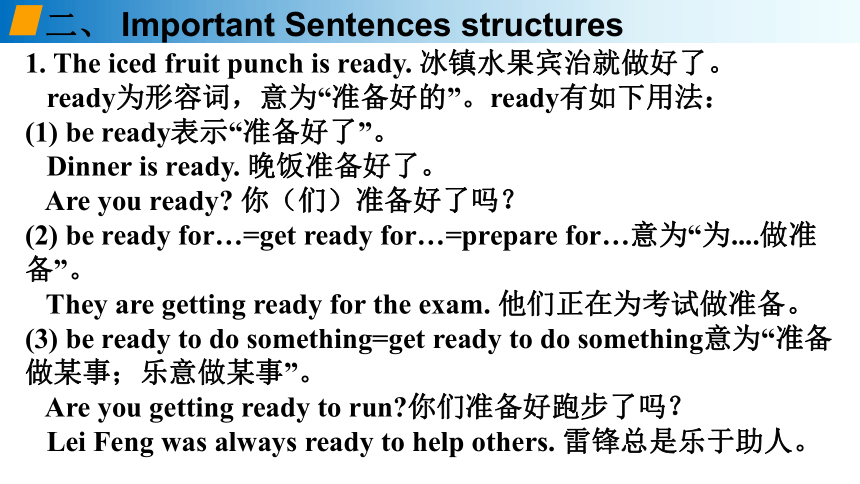
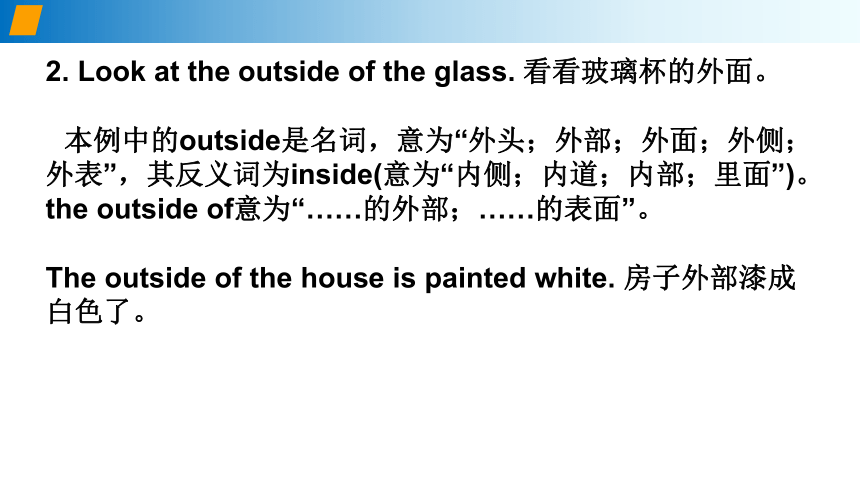
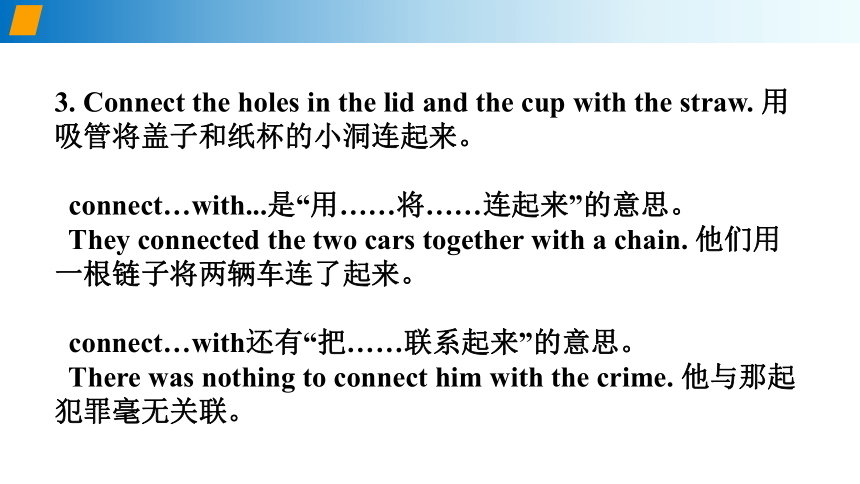

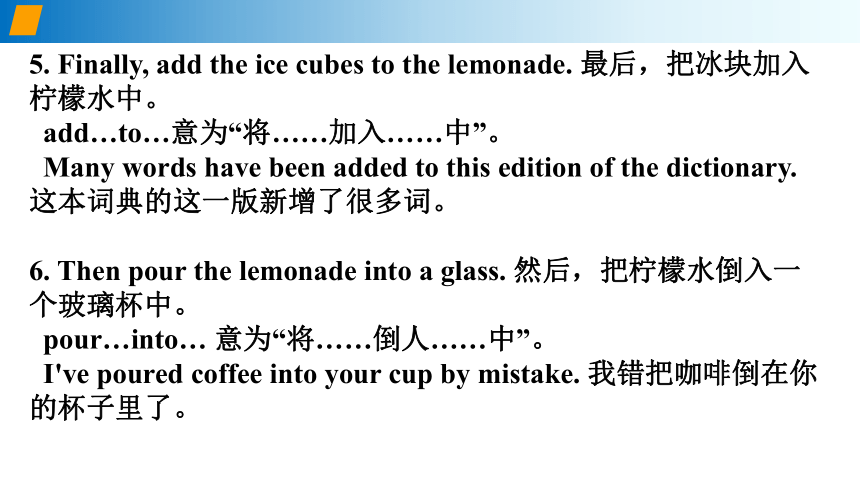
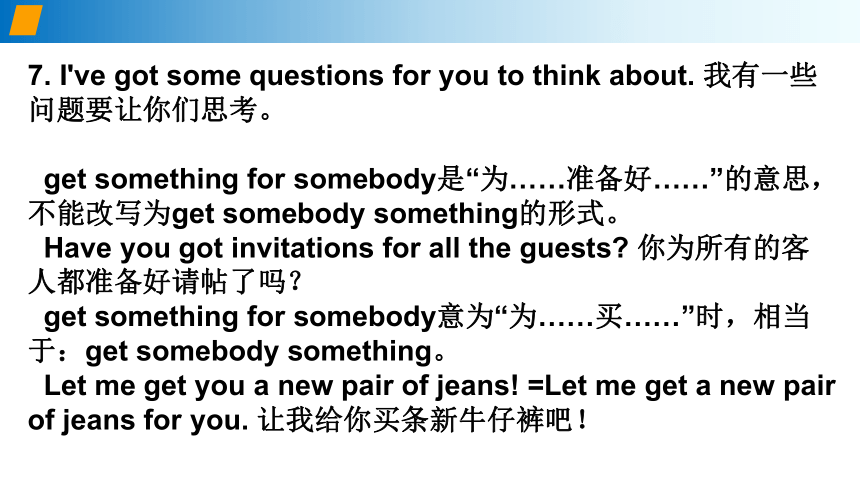
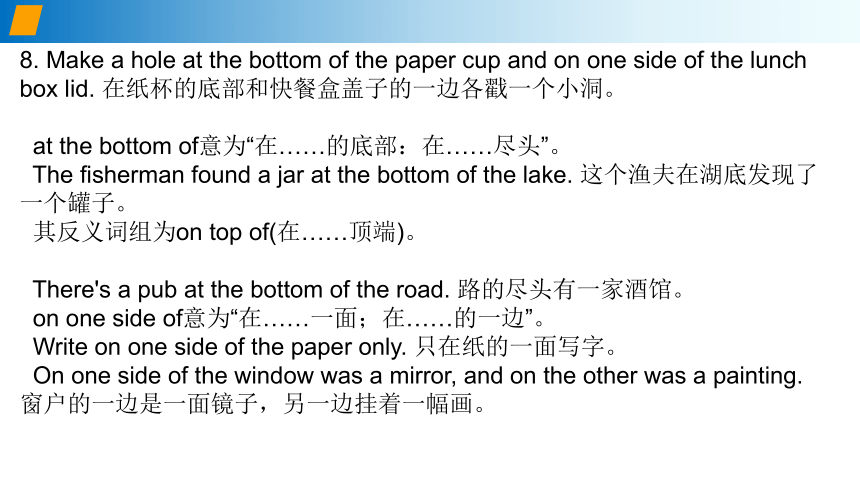
文档简介
(共23张PPT)
All things in their being are good for something.
天生我材必有用。
沪教版 英语 七年级 第二学期
Lead in— 学海拾贝
既然这个事物或人存在,它肯定有自己的价值。
In other words, Since this thing or person exists in this world, it or he must have some value.
一、知识回顾
n. 形态;形式
v.(使)冻结,结冰
n.(容器的)盖;盖子
n. 秒
n. 洞,孔,坑
n. 边
v.(使)连接
v.允许;准许
n. 安全
1. 单词默写。
二、 Important Sentences structures
1. The iced fruit punch is ready. 冰镇水果宾治就做好了。
ready为形容词,意为“准备好的”。ready有如下用法:
(1) be ready表示“准备好了”。
Dinner is ready. 晚饭准备好了。
Are you ready 你(们)准备好了吗?
(2) be ready for…=get ready for…=prepare for…意为“为....做准备”。
They are getting ready for the exam. 他们正在为考试做准备。
(3) be ready to do something=get ready to do something意为“准备做某事;乐意做某事”。
Are you getting ready to run 你们准备好跑步了吗?
Lei Feng was always ready to help others. 雷锋总是乐于助人。
2. Look at the outside of the glass. 看看玻璃杯的外面。
本例中的outside是名词,意为“外头;外部;外面;外侧;外表”,其反义词为inside(意为“内侧;内道;内部;里面”)。the outside of意为“……的外部;……的表面”。
The outside of the house is painted white. 房子外部漆成白色了。
3. Connect the holes in the lid and the cup with the straw. 用吸管将盖子和纸杯的小洞连起来。
connect…with...是“用……将……连起来”的意思。
They connected the two cars together with a chain. 他们用一根链子将两辆车连了起来。
connect…with还有“把……联系起来”的意思。
There was nothing to connect him with the crime. 他与那起犯罪毫无关联。
4. Next, make ice cubes out of the different kinds of fruit juice. 接着,把不同的果汁做成冰块。
make…out of意为‘‘用……来制作……”。
Many things are made out of bamboo. 很多东西是由竹子制作的。
Some children make lanterns out of pumpkins at Halloween. 万圣节时,一些孩子用南瓜做灯笼。
different kinds of意为“不同种类的”。
She offered us five different kinds of cakes. 她给我们提供了五种不同的蛋糕。
5. Finally, add the ice cubes to the lemonade. 最后,把冰块加入柠檬水中。
add…to…意为“将……加入……中”。
Many words have been added to this edition of the dictionary. 这本词典的这一版新增了很多词。
6. Then pour the lemonade into a glass. 然后,把柠檬水倒入一个玻璃杯中。
pour…into… 意为“将……倒人……中”。
I've poured coffee into your cup by mistake. 我错把咖啡倒在你的杯子里了。
7. I've got some questions for you to think about. 我有一些问题要让你们思考。
get something for somebody是“为……准备好……”的意思,不能改写为get somebody something的形式。
Have you got invitations for all the guests 你为所有的客人都准备好请帖了吗?
get something for somebody意为“为……买……’’时,相当于:get somebody something。
Let me get you a new pair of jeans! =Let me get a new pair of jeans for you. 让我给你买条新牛仔裤吧!
8. Make a hole at the bottom of the paper cup and on one side of the lunch box lid. 在纸杯的底部和快餐盒盖子的一边各戳一个小洞。
at the bottom of意为“在……的底部:在……尽头”。
The fisherman found a jar at the bottom of the lake. 这个渔夫在湖底发现了一个罐子。
其反义词组为on top of(在……顶端)。
There's a pub at the bottom of the road. 路的尽头有一家酒馆。
on one side of意为“在……一面;在……的一边”。
Write on one side of the paper only. 只在纸的一面写字。
On one side of the window was a mirror, and on the other was a painting.
窗户的一边是一面镜子,另一边挂着一幅画。
9. Fishing is not allowed. 禁止钓鱼。
fish在这里是动词,意为“钓鱼”。由于fish在这里作主语,而主语一般由名词或代词充当,因此,须使用动名词(即动词ing形式)。
Running is my favourite sport. 跑步是我最喜欢的运动。
Learning English becomes more and more important in our daily life. 在我们的日常生活中,学习英语变得越来越重要。
be allowed意为“被允许”,是被动语态结构。很多规则可以用be( not) allowed的结构来表达。
Ball games are not allowed here. 此处不允许进行球类游戏。
Cycling is allowed here. 此处可以骑车。
要表达“被允许做某事”或“不允许做某事”的意思,则使用be(not)allowed to do something的结构。
You are allowed to cycle here. 你可以在此处骑车。
You are not allowed to park here. 你不可以在此处停车。
1. Many people are planting trees outside. (对划线部分提问)
____________ are many people ____________ outside
2. We felt tired and thirsty after running for an hour. (对划线部分提问)
____________ did you ____________ after running for an hour
3. It is great fun to go skating in winter. (改为感叹句)
____________ ____________ ____________ it is to go skating in winter!
4. There is very little snow in Shanghai in winter.(改为反义疑问句)
There is very little snow in Shanghai in winter, ____________ ____________
5. My cousin has been an architect since 2002. (对划线部分提问)
____________ ____________ has your cousin been an architect
What doing, How feel, What great fun, is there, How long
【随堂小练】
三、语法讲解
★When的用法
(一)作为副词,它有以下的用法:
1. 作为疑问副词,引导特殊疑问句,意为“什么时候;何时”,例如:
(1) When will they come back (2)What time will they come back
回答when引导的从句,不一定指出具体的时间点。如回答句(1)可用tomorrow, next month等。
2. 作连接副词,引导名词性从句或不定式,意为“什么时候”。从句使用陈述句语序,时态根据实际情况而定。
Have you decided when to go sightseeing 你们已经决定什么时候去郊游了吗?(when引导不定式结构)
(二)作为从属连词,引导状语从句,表示多种语法意义:
表示时间,意为“当……时,在……的时候”。
A. 在时间、条件等状语从句里,用一般现在时表示将来时,当需要表达将来完成的意义时,必须使用现在完成时来代替。如:
When you see him, please say hello to him. 见到他时,代我问他好。
B. 表示过去发生的事情,在when引导的时间状语从句的主从复合句中,动作发生在先的用过去完成时,在后的用过去时。如:
When I was in Japan, I bought some beautiful pearls. 我在日本时,买了一些漂亮的珍珠。
★No ball games. 禁止球类游戏。
除了使用祈使句及带有情态动词的句子表示不同的规则之外,我们也可以使用no来表示禁止某项活动的规则,no后一般可加名词或动词ing形式。本例中的句子也相当于Don't play ball games!或We mustn't play ball games here!。使用no的句子表达各类规则时显得更为简练。
No U-turn!禁止调头!
No parking here!此处禁止停车!
【随堂小练】
Complete the following sentences as required(根据所给要求完成句子。每空格限填一词)
1.We had some fast food for our lunch.(对划线部分提问)
__________ __________ you have for your lunch
2.You mustn’t feed the goldfish too much food.(保持句意不变)
__________ __________ the goldfish too much food.
3.My sister prefers the lovely toy dog.(对划线部分提问)__________ __________ your sister prefer
4.Class 4 students visited the car factory last week.(对划线部分提问)
__________ __________ Class 4 students visit the car factory
5.With the help of the dog, the police found the thief.(改为一般疑问句)
__________ the police __________ the thief with the help of the dog
6.It took the workers two years to build the bridge.(保持句意不变)
The workers __________ two years __________ the bridge.
7.Both Ben and John have been to Beijing.(改为否定句)
__________ Ben __________ John has been to Beijing.
1. What did 2. Don't feed 3. What does 4. When did
5. Did find 6. spent on/building 7. Neither nor
1.对划线部分some fast food进行提问,应问你午餐吃什么了。what什么。且特殊疑问句的结构为“特殊疑问词+一般疑问句”。根据had可知,用一般过去时,根据have可知,用助动词did,空位于句首,故填What和did。
2.第一句话的句意为“你禁止喂金鱼太多食物”可以转化为祈使句“不要喂金鱼太多食物”。祈使句省略主语you,以动词原形开头,变为否定时,在前面加don’t,空位于句首,故填Don’t feed。
3.对the lovely toy dog进行提问,应问“你的妹妹更喜欢什么?”。what什么,特殊疑问句的结构为“特殊疑问词+一般疑问句”,第一句话为一般现在时,且根据prefer动词原形可知,用助动词,主语为your sister,用does,空位于句首,故填What和does。
4.对last week进行提问,问时间,when什么时候,特殊疑问句的结构为“特殊疑问词+一般疑问句”,根据第一句话中的visited可知,用一般过去时,再根据visit可知,用助动词。空位于句首,故填When和did。
5.变成一般疑问句,将be动词/助动词/情态动词提前。本句话中将助动词提前,根据found可知,用一般过去时did,且助动词后用动词原形,空位于句首,故填Did和find。
6.第一句话译为“建造这个桥花了工人两年时间”可转化为“工人花了两年时间建这个桥”。可以用“人+spend+时间+(in)doing”或“人+spend+时间+on sth”结构。根据took可知,用一般过去时spent,且第二空后为the bridge,用on/building,故填spent和on/building。
7.both...and...两者都;否定形式为neither...nor...“既不……也不……”,且空位于句首,故填Neither和nor。
8.It’s ten minutes’ walk from my home to the theatre. (对划线部分提问)
________ ________ is it from your home to the theatre
9.Don’t fish in the pool.(保持句意基本不变)
Fishing ________ ________ in the pool.
10.Throwing coins into the fountain is not allowed.(保持句意基本不变)
We ________ ________ coins into the fountain.
11.Shall we get up early to watch the sunrise (保持句意基本不变)
________ ________ getting up early to watch the sunrise
12.We mustn’t fish here. (保持句意不变)
Fishing ____ ____ here.
13.Jenny put all the signs in the box yesterday.(改为否定句)
Jenny ________ ________all the signs in the box yesterday.
8. How far【详解】
句意:从我家到剧院走路要十分钟。划线部分表示从说话人的家到剧院的距离,对此提问用“how far”,表示多远,句首首字母h大写。故填How;far。
9. isn’t allowed【详解】
句意:不要在游泳池里钓鱼。原句可表示“游泳池里不准钓鱼”,allow“允许”,主语是动作的承受者,时态是一般现在时,所以用一般现在时的被动语态。故填isn’t;allowed。
10.shouldn’t throw【详解】
句意:将硬币扔进喷泉是不被允许的。改为同义句时,主语是we,应用主动形式,表示“我们不应该扔硬币到喷泉里”,shouldn’t“不应该”,情态动词,其后加动词原形throw“扔”。故填shouldn’t;throw。
11.What about【详解】
句意:我们早起看日出好吗?结合题干可知,此题考查:what about意为“……怎么样?” ,用来征求意见,后跟动名词,首字母大写。故填What;about。
12.isn’t allowed【详解】
句意:我们不能在这里钓鱼。由句意可知,同义句可改为“钓鱼在这里不被允许”,主语是fishing,用一般现在时的被动语态am/is/are done,主语是动名词,be动词用is,allow“允许”的过去分词是allowed。故填isn’t;allowed。
13.didn’t put【详解】
句意:昨天珍妮把所有的标牌放到箱子里。原句为一般过去时的陈述句,改为否定句需要用助动词did,在did后加not即可,did not=didn’t,后面需要加动词原形。故填didn’t;put。
14.I’d like to be a policeman because a policeman always keeps our city__________.
A.save B.safe C.safely D.safety
15.—Let’s join the comic club and enjoy some cartoons.
—________.
A.You are quite right B.I agree
C.Of course we do D.That’s a good idea
16.When the ice melts, it ________ water.
A.turns on B.turned into C.turns into D.turned on
17.I don’t know ________ to bake a cake, so I ask my mother for help.
A.what B.how C.where D.when
14.B
【详解】
句意:我想成为一名警察,因为警察总是保持我们的城市安全。
考查形容词用法。save动词,“拯救”;safe形容词,“安全的”;safely副词,“安全地”;safety名词,“安全”。根据句子结构可知,应填形容词做宾语补足语。故选B。
15.D
【详解】
句意:——让我们加入漫画俱乐部,享受一些卡通片吧。——这是个好主意。
考查口语交际。You are quite right你说得很对;I agree我同意;Of course we do我们当然会;That’s a good idea这是个好主意。根据“Let’s join the comic club and enjoy some cartoons”可知,上文提出建议,That’s a good idea是对该建议的评价,表示赞同;B项通常是表示同意某种观点,用在此处不合语境。故选D。
16.C
【详解】
句意:当冰融化时,它会变成水。
考查时态和动词短语。turn on打开;turn into变成。根据“ice melts...water”可知,此处指冰变成水,排除AD;“When the ice melts”可知,使用一般现在时。故选C。
17.B
【详解】
句意:我不知道怎么烤蛋糕,所以我请妈妈帮忙。
考查宾语从句。what什么;how怎样;where哪里;when何时。根据“I don’t know…to bake a cake”可知,不知道如何烤蛋糕,故选B。
18.People ________ leave rubbish on the ground.
A.mustn’t B.needn’t C.must D.need
19.He lives in the ________ building in the community. It’s a building with ________ floors.
A.second; three B.second, third C.two; three D.two; third
20.—May I use your notebook
—________
A.Well done. B.I don’t think so. C.OK, here you are. D.See you soon.
21.—Could I go to play with Tom now, Mum
— __________. I saw him go out with his parents just now.
A.No, I can’t B.No, you couldn’t
C.Of course you can D.I’m afraid you can’t
18.A
【详解】
句意:人们不能把垃圾扔在地上。
考查情态动词。mustn’t禁止;needn’t不需要;must必须;need需要。根据“People...leave rubbish on the ground.”可知,此处是指禁止把垃圾扔地下。故选A。
19.A
【详解】
句意:他住在社区的第二栋楼。这是一栋三层的建筑。
考查数词的用法。second第二;three三;third第三;two二。空一“lives in the...building”表示顺序,用序数词,可排除CD选项;空二“...floors”表示具体的数量,用基数词。故选A。
20.C
【详解】
句意:——我可以用你的笔记本吗?——好的,给你。
考查情景交际。Well done.干得好。I don’t think so.我不这么认为。OK, here you are.好的,给你。See you soon.再见。根据“May I use your notebook ”可知要借用笔记本,可以用“OK, here you are.”表示同意。故选C。
21.D
【详解】
句意:——妈妈,我现在能和汤姆一起玩吗?——恐怕不行。我刚才看见他和父母出去了。
考查情景交际。No, I can’t不,我不行;No, you couldn’t不,你不行;Of course you can当然可以;I’m afraid you can’t恐怕不行。根据“Could I go to play with Tom now, Mum ”可知,此处表示委婉语气,用“Could”提问,用“can”来回答,排除B选项;再根据“I saw him go out with his parents just now.”可知,此处作否定回答,D选项符合语境。故选D。
愿君皆有所获,皆有所得
All things in their being are good for something.
天生我材必有用。
沪教版 英语 七年级 第二学期
Lead in— 学海拾贝
既然这个事物或人存在,它肯定有自己的价值。
In other words, Since this thing or person exists in this world, it or he must have some value.
一、知识回顾
n. 形态;形式
v.(使)冻结,结冰
n.(容器的)盖;盖子
n. 秒
n. 洞,孔,坑
n. 边
v.(使)连接
v.允许;准许
n. 安全
1. 单词默写。
二、 Important Sentences structures
1. The iced fruit punch is ready. 冰镇水果宾治就做好了。
ready为形容词,意为“准备好的”。ready有如下用法:
(1) be ready表示“准备好了”。
Dinner is ready. 晚饭准备好了。
Are you ready 你(们)准备好了吗?
(2) be ready for…=get ready for…=prepare for…意为“为....做准备”。
They are getting ready for the exam. 他们正在为考试做准备。
(3) be ready to do something=get ready to do something意为“准备做某事;乐意做某事”。
Are you getting ready to run 你们准备好跑步了吗?
Lei Feng was always ready to help others. 雷锋总是乐于助人。
2. Look at the outside of the glass. 看看玻璃杯的外面。
本例中的outside是名词,意为“外头;外部;外面;外侧;外表”,其反义词为inside(意为“内侧;内道;内部;里面”)。the outside of意为“……的外部;……的表面”。
The outside of the house is painted white. 房子外部漆成白色了。
3. Connect the holes in the lid and the cup with the straw. 用吸管将盖子和纸杯的小洞连起来。
connect…with...是“用……将……连起来”的意思。
They connected the two cars together with a chain. 他们用一根链子将两辆车连了起来。
connect…with还有“把……联系起来”的意思。
There was nothing to connect him with the crime. 他与那起犯罪毫无关联。
4. Next, make ice cubes out of the different kinds of fruit juice. 接着,把不同的果汁做成冰块。
make…out of意为‘‘用……来制作……”。
Many things are made out of bamboo. 很多东西是由竹子制作的。
Some children make lanterns out of pumpkins at Halloween. 万圣节时,一些孩子用南瓜做灯笼。
different kinds of意为“不同种类的”。
She offered us five different kinds of cakes. 她给我们提供了五种不同的蛋糕。
5. Finally, add the ice cubes to the lemonade. 最后,把冰块加入柠檬水中。
add…to…意为“将……加入……中”。
Many words have been added to this edition of the dictionary. 这本词典的这一版新增了很多词。
6. Then pour the lemonade into a glass. 然后,把柠檬水倒入一个玻璃杯中。
pour…into… 意为“将……倒人……中”。
I've poured coffee into your cup by mistake. 我错把咖啡倒在你的杯子里了。
7. I've got some questions for you to think about. 我有一些问题要让你们思考。
get something for somebody是“为……准备好……”的意思,不能改写为get somebody something的形式。
Have you got invitations for all the guests 你为所有的客人都准备好请帖了吗?
get something for somebody意为“为……买……’’时,相当于:get somebody something。
Let me get you a new pair of jeans! =Let me get a new pair of jeans for you. 让我给你买条新牛仔裤吧!
8. Make a hole at the bottom of the paper cup and on one side of the lunch box lid. 在纸杯的底部和快餐盒盖子的一边各戳一个小洞。
at the bottom of意为“在……的底部:在……尽头”。
The fisherman found a jar at the bottom of the lake. 这个渔夫在湖底发现了一个罐子。
其反义词组为on top of(在……顶端)。
There's a pub at the bottom of the road. 路的尽头有一家酒馆。
on one side of意为“在……一面;在……的一边”。
Write on one side of the paper only. 只在纸的一面写字。
On one side of the window was a mirror, and on the other was a painting.
窗户的一边是一面镜子,另一边挂着一幅画。
9. Fishing is not allowed. 禁止钓鱼。
fish在这里是动词,意为“钓鱼”。由于fish在这里作主语,而主语一般由名词或代词充当,因此,须使用动名词(即动词ing形式)。
Running is my favourite sport. 跑步是我最喜欢的运动。
Learning English becomes more and more important in our daily life. 在我们的日常生活中,学习英语变得越来越重要。
be allowed意为“被允许”,是被动语态结构。很多规则可以用be( not) allowed的结构来表达。
Ball games are not allowed here. 此处不允许进行球类游戏。
Cycling is allowed here. 此处可以骑车。
要表达“被允许做某事”或“不允许做某事”的意思,则使用be(not)allowed to do something的结构。
You are allowed to cycle here. 你可以在此处骑车。
You are not allowed to park here. 你不可以在此处停车。
1. Many people are planting trees outside. (对划线部分提问)
____________ are many people ____________ outside
2. We felt tired and thirsty after running for an hour. (对划线部分提问)
____________ did you ____________ after running for an hour
3. It is great fun to go skating in winter. (改为感叹句)
____________ ____________ ____________ it is to go skating in winter!
4. There is very little snow in Shanghai in winter.(改为反义疑问句)
There is very little snow in Shanghai in winter, ____________ ____________
5. My cousin has been an architect since 2002. (对划线部分提问)
____________ ____________ has your cousin been an architect
What doing, How feel, What great fun, is there, How long
【随堂小练】
三、语法讲解
★When的用法
(一)作为副词,它有以下的用法:
1. 作为疑问副词,引导特殊疑问句,意为“什么时候;何时”,例如:
(1) When will they come back (2)What time will they come back
回答when引导的从句,不一定指出具体的时间点。如回答句(1)可用tomorrow, next month等。
2. 作连接副词,引导名词性从句或不定式,意为“什么时候”。从句使用陈述句语序,时态根据实际情况而定。
Have you decided when to go sightseeing 你们已经决定什么时候去郊游了吗?(when引导不定式结构)
(二)作为从属连词,引导状语从句,表示多种语法意义:
表示时间,意为“当……时,在……的时候”。
A. 在时间、条件等状语从句里,用一般现在时表示将来时,当需要表达将来完成的意义时,必须使用现在完成时来代替。如:
When you see him, please say hello to him. 见到他时,代我问他好。
B. 表示过去发生的事情,在when引导的时间状语从句的主从复合句中,动作发生在先的用过去完成时,在后的用过去时。如:
When I was in Japan, I bought some beautiful pearls. 我在日本时,买了一些漂亮的珍珠。
★No ball games. 禁止球类游戏。
除了使用祈使句及带有情态动词的句子表示不同的规则之外,我们也可以使用no来表示禁止某项活动的规则,no后一般可加名词或动词ing形式。本例中的句子也相当于Don't play ball games!或We mustn't play ball games here!。使用no的句子表达各类规则时显得更为简练。
No U-turn!禁止调头!
No parking here!此处禁止停车!
【随堂小练】
Complete the following sentences as required(根据所给要求完成句子。每空格限填一词)
1.We had some fast food for our lunch.(对划线部分提问)
__________ __________ you have for your lunch
2.You mustn’t feed the goldfish too much food.(保持句意不变)
__________ __________ the goldfish too much food.
3.My sister prefers the lovely toy dog.(对划线部分提问)__________ __________ your sister prefer
4.Class 4 students visited the car factory last week.(对划线部分提问)
__________ __________ Class 4 students visit the car factory
5.With the help of the dog, the police found the thief.(改为一般疑问句)
__________ the police __________ the thief with the help of the dog
6.It took the workers two years to build the bridge.(保持句意不变)
The workers __________ two years __________ the bridge.
7.Both Ben and John have been to Beijing.(改为否定句)
__________ Ben __________ John has been to Beijing.
1. What did 2. Don't feed 3. What does 4. When did
5. Did find 6. spent on/building 7. Neither nor
1.对划线部分some fast food进行提问,应问你午餐吃什么了。what什么。且特殊疑问句的结构为“特殊疑问词+一般疑问句”。根据had可知,用一般过去时,根据have可知,用助动词did,空位于句首,故填What和did。
2.第一句话的句意为“你禁止喂金鱼太多食物”可以转化为祈使句“不要喂金鱼太多食物”。祈使句省略主语you,以动词原形开头,变为否定时,在前面加don’t,空位于句首,故填Don’t feed。
3.对the lovely toy dog进行提问,应问“你的妹妹更喜欢什么?”。what什么,特殊疑问句的结构为“特殊疑问词+一般疑问句”,第一句话为一般现在时,且根据prefer动词原形可知,用助动词,主语为your sister,用does,空位于句首,故填What和does。
4.对last week进行提问,问时间,when什么时候,特殊疑问句的结构为“特殊疑问词+一般疑问句”,根据第一句话中的visited可知,用一般过去时,再根据visit可知,用助动词。空位于句首,故填When和did。
5.变成一般疑问句,将be动词/助动词/情态动词提前。本句话中将助动词提前,根据found可知,用一般过去时did,且助动词后用动词原形,空位于句首,故填Did和find。
6.第一句话译为“建造这个桥花了工人两年时间”可转化为“工人花了两年时间建这个桥”。可以用“人+spend+时间+(in)doing”或“人+spend+时间+on sth”结构。根据took可知,用一般过去时spent,且第二空后为the bridge,用on/building,故填spent和on/building。
7.both...and...两者都;否定形式为neither...nor...“既不……也不……”,且空位于句首,故填Neither和nor。
8.It’s ten minutes’ walk from my home to the theatre. (对划线部分提问)
________ ________ is it from your home to the theatre
9.Don’t fish in the pool.(保持句意基本不变)
Fishing ________ ________ in the pool.
10.Throwing coins into the fountain is not allowed.(保持句意基本不变)
We ________ ________ coins into the fountain.
11.Shall we get up early to watch the sunrise (保持句意基本不变)
________ ________ getting up early to watch the sunrise
12.We mustn’t fish here. (保持句意不变)
Fishing ____ ____ here.
13.Jenny put all the signs in the box yesterday.(改为否定句)
Jenny ________ ________all the signs in the box yesterday.
8. How far【详解】
句意:从我家到剧院走路要十分钟。划线部分表示从说话人的家到剧院的距离,对此提问用“how far”,表示多远,句首首字母h大写。故填How;far。
9. isn’t allowed【详解】
句意:不要在游泳池里钓鱼。原句可表示“游泳池里不准钓鱼”,allow“允许”,主语是动作的承受者,时态是一般现在时,所以用一般现在时的被动语态。故填isn’t;allowed。
10.shouldn’t throw【详解】
句意:将硬币扔进喷泉是不被允许的。改为同义句时,主语是we,应用主动形式,表示“我们不应该扔硬币到喷泉里”,shouldn’t“不应该”,情态动词,其后加动词原形throw“扔”。故填shouldn’t;throw。
11.What about【详解】
句意:我们早起看日出好吗?结合题干可知,此题考查:what about意为“……怎么样?” ,用来征求意见,后跟动名词,首字母大写。故填What;about。
12.isn’t allowed【详解】
句意:我们不能在这里钓鱼。由句意可知,同义句可改为“钓鱼在这里不被允许”,主语是fishing,用一般现在时的被动语态am/is/are done,主语是动名词,be动词用is,allow“允许”的过去分词是allowed。故填isn’t;allowed。
13.didn’t put【详解】
句意:昨天珍妮把所有的标牌放到箱子里。原句为一般过去时的陈述句,改为否定句需要用助动词did,在did后加not即可,did not=didn’t,后面需要加动词原形。故填didn’t;put。
14.I’d like to be a policeman because a policeman always keeps our city__________.
A.save B.safe C.safely D.safety
15.—Let’s join the comic club and enjoy some cartoons.
—________.
A.You are quite right B.I agree
C.Of course we do D.That’s a good idea
16.When the ice melts, it ________ water.
A.turns on B.turned into C.turns into D.turned on
17.I don’t know ________ to bake a cake, so I ask my mother for help.
A.what B.how C.where D.when
14.B
【详解】
句意:我想成为一名警察,因为警察总是保持我们的城市安全。
考查形容词用法。save动词,“拯救”;safe形容词,“安全的”;safely副词,“安全地”;safety名词,“安全”。根据句子结构可知,应填形容词做宾语补足语。故选B。
15.D
【详解】
句意:——让我们加入漫画俱乐部,享受一些卡通片吧。——这是个好主意。
考查口语交际。You are quite right你说得很对;I agree我同意;Of course we do我们当然会;That’s a good idea这是个好主意。根据“Let’s join the comic club and enjoy some cartoons”可知,上文提出建议,That’s a good idea是对该建议的评价,表示赞同;B项通常是表示同意某种观点,用在此处不合语境。故选D。
16.C
【详解】
句意:当冰融化时,它会变成水。
考查时态和动词短语。turn on打开;turn into变成。根据“ice melts...water”可知,此处指冰变成水,排除AD;“When the ice melts”可知,使用一般现在时。故选C。
17.B
【详解】
句意:我不知道怎么烤蛋糕,所以我请妈妈帮忙。
考查宾语从句。what什么;how怎样;where哪里;when何时。根据“I don’t know…to bake a cake”可知,不知道如何烤蛋糕,故选B。
18.People ________ leave rubbish on the ground.
A.mustn’t B.needn’t C.must D.need
19.He lives in the ________ building in the community. It’s a building with ________ floors.
A.second; three B.second, third C.two; three D.two; third
20.—May I use your notebook
—________
A.Well done. B.I don’t think so. C.OK, here you are. D.See you soon.
21.—Could I go to play with Tom now, Mum
— __________. I saw him go out with his parents just now.
A.No, I can’t B.No, you couldn’t
C.Of course you can D.I’m afraid you can’t
18.A
【详解】
句意:人们不能把垃圾扔在地上。
考查情态动词。mustn’t禁止;needn’t不需要;must必须;need需要。根据“People...leave rubbish on the ground.”可知,此处是指禁止把垃圾扔地下。故选A。
19.A
【详解】
句意:他住在社区的第二栋楼。这是一栋三层的建筑。
考查数词的用法。second第二;three三;third第三;two二。空一“lives in the...building”表示顺序,用序数词,可排除CD选项;空二“...floors”表示具体的数量,用基数词。故选A。
20.C
【详解】
句意:——我可以用你的笔记本吗?——好的,给你。
考查情景交际。Well done.干得好。I don’t think so.我不这么认为。OK, here you are.好的,给你。See you soon.再见。根据“May I use your notebook ”可知要借用笔记本,可以用“OK, here you are.”表示同意。故选C。
21.D
【详解】
句意:——妈妈,我现在能和汤姆一起玩吗?——恐怕不行。我刚才看见他和父母出去了。
考查情景交际。No, I can’t不,我不行;No, you couldn’t不,你不行;Of course you can当然可以;I’m afraid you can’t恐怕不行。根据“Could I go to play with Tom now, Mum ”可知,此处表示委婉语气,用“Could”提问,用“can”来回答,排除B选项;再根据“I saw him go out with his parents just now.”可知,此处作否定回答,D选项符合语境。故选D。
愿君皆有所获,皆有所得
同课章节目录
- Module 1 Garden City and its neighbours
- Unit 1 Writing a travel guide
- Unit 2 Going to see a film
- Unit 3 A visit to Garden City
- Module 2 Better future
- Unit 4 Let's go shopping
- Unit 5 What can we learn from others?
- Unit 6 Hard work for a better life
- Unit 7 in the future
- Module 3 The natural elements
- Unit 8 A more enjoyable school life
- Unit 9 The wind is blowing
- Unit 10 Water Festival
- Unit 11 Electricity
